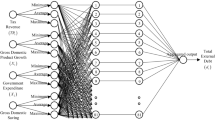Abstract
Recently, the total public debt outstanding (TPDO) of the United States has increased rapidly, and to more than \(\$17\) trillion on October 18, 2013. It is important and necessary to conduct the TPDO projection for better policies making and more effective measurements taken. In this paper, we present the ten-year projection for the public debt of the United States (termed also the US public debt, USPD) via a 3-layer feed-forward neuronet. Specifically, using the calendar year data on the USPD from the Department of the Treasury, the neuronet is trained, and then is applied to projection. Via a series of numerical tests, we find that there are several possibilities of the change of the USPD in the future, which are classified into two categories in terms of projection trend: the continuous-increase trend and the increase-peak-decline trend. In the most possible situation, the neuronet indicates that the TPDO of the United States is projected to increase, and it will double in 2019 and double again in 2024.
Access this chapter
Tax calculation will be finalised at checkout
Purchases are for personal use only
Similar content being viewed by others
References
US Government Accountability Office: Federal Debt Basics - How Large is the Federal Debt? Government Accountability Office, Washington, D.C. (2012)
US Government Accountability Office: The Nation’s Long-Term Fiscal Outlook: September 2008 Update. Government Accountability Office, Washington, D.C. (2008)
Friedman, B.M.: Debt and Economic Activity in the United States. University of Chicago Press, Chicago (1982)
US Department of the Treasury: Public Debt Reports: Historical Debt Outstanding - Annual. Department of the Treasury, Washington, D.C. (2013)
US Congressional Budget Office: Updated Budget Projections: Fiscal Years 2013 to 2023. Congressional Budget Office, Washington, D.C. (2013)
US Congressional Budget Office: The 2013 Long-Term Budget Outlook. Congressional Budget Office, Washington, D.C. (2013)
Chernew, M.E., Baicker, K., Hsu, J.: The specter of financial armageddon-health care and federal debt in the united states. New Engl. J. Med. 362(13), 1166–1168 (2010)
Young, J.A.: Technology and competitiveness: a key to the economic future of the united states. Science 241(4863), 313–316 (1998)
Ooms, V.D.: Budget priorities of the nation. Science 258(5089), 1742–1747 (1992)
Sarno, L.: The behavior of US public debt: a nonlinear perspective. Econ. Lett. 74(1), 119–125 (2001)
Greiner, A., Kauermann, G.: Sustainability of US public debt: estimating smoothing spline regressions. Econ. Modell. 24(2), 350–364 (2007)
Aizenman, J., Marion, N.: Using inflation to erode the US public debt. J. Macroecon. 33(4), 524–541 (2011)
US Office of Management and Budget: The Budget for Fiscal Year 2013. Historical Tables. Washington, D.C. Office of Management and Budget (2013)
Celasun, O., Keim, G.: The U.S. Federal Debt Outlook: Reading the Tea Leaves. IMF Working Paper, International Monetary Fund, United States (2010)
Cecchetti, S.G., Mohanty, M.S., Zampolli, F.: The Future of Public Debt: Prospects and Implications. Bank for International Settlements, Monetary and Economic Department (2010)
Meuhleisen, M., Towe, C.M., Cardarelli, R.: United States Fiscal Policies and Priorities for Long-Run Sustainability. International Monetary Fund, United States (2004)
Bohn, H.: The behavior of U.S public debt and deficits. Q. J. Econ. 113(3), 949–963 (1998)
Zhang, Y., Yu, X., Xiao, L., Li, W., Fan, Z.: Weights and Structure Determination of Artificial Neuronets (Chapter 5). Nova Science Publishers, New York (2013)
Zhang, Y., Chen, Y., Jiang, X., Zeng, Q., Zou, A.: Weights-directly-determined and structure-adaptively-tuned neural network based on chebyshev basis functions. Comput. Sci. 36, 210–213 (2009)
Ferone, A., Maddalena, L.: Neural background subtraction for pan-tilt-zoom cameras. IEEE Trans. Syst. Man Cybern. Syst. 44(5), 571–579 (2014)
Henriquez, P., Alonso, J.B., Ferrer, M.A., Travieso, C.M.: Review of automatic fault diagnosis systems using audio and vibration signals. IEEE Trans. Syst. Man Cybern. Syst. 44(5), 642–652 (2014)
Ge, S.S., Yang, C., Lee, T.H.: Adaptive predictive control using neural network for a class of pure-feedback systems in discrete time. IEEE Trans. Neural Netw. 19(9), 1599–1614 (2008)
Wang, Z., Liu, Y., Li, M., Liu, X.: Stability analysis for stochastic cohen-grossberg neural networks with mixed time delays. IEEE Trans. Neural Netw. 17(3), 814–820 (2006)
Kabir, H., Wang, Y., Yu, M., Zhang, Q.: High-dimensional neural-network technique and applications to microwave filter modeling. IEEE Trans. Microw. Theory Tech. 58(1), 145–156 (2010)
Liang, X., Wang, J.: A recurrent neural network for nonlinear optimization with a continuously differentiable objective function and bound constraints. IEEE Trans. Neural Netw. 11(6), 1251–1262 (2000)
US Department of the Treasury: Public Debt Reports: Monthly Statement of the Public Debt (MSPD) and Downloadable Files. Department of the Treasury, Washington, D.C. (2013)
Acknowledgments
This work is supported by the National Natural Science Foundation of China (with number 61473323), by the Foundation of Key Laboratory of Autonomous Systems and Networked Control, Ministry of Education, China (with number 2013A07), and also by the Science and Technology Program of Guangzhou, China (with number 2014J4100057).
Author information
Authors and Affiliations
Corresponding author
Editor information
Editors and Affiliations
Rights and permissions
Copyright information
© 2016 Springer Science+Business Media Singapore
About this paper
Cite this paper
Zhang, Y., Xiao, Z., Guo, D., Mao, M., Tan, H. (2016). USPD Doubling or Declining in Next Decade Estimated by WASD Neuronet Using Data as of October 2013. In: Li, K., Li, J., Liu, Y., Castiglione, A. (eds) Computational Intelligence and Intelligent Systems. ISICA 2015. Communications in Computer and Information Science, vol 575. Springer, Singapore. https://doi.org/10.1007/978-981-10-0356-1_75
Download citation
DOI: https://doi.org/10.1007/978-981-10-0356-1_75
Published:
Publisher Name: Springer, Singapore
Print ISBN: 978-981-10-0355-4
Online ISBN: 978-981-10-0356-1
eBook Packages: Computer ScienceComputer Science (R0)




